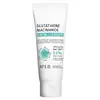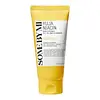What's inside
What's inside
 Key Ingredients
Key Ingredients

 Benefits
Benefits

 Concerns
Concerns

 Ingredients Side-by-side
Ingredients Side-by-side

Water
Skin ConditioningGlycerin
HumectantStearic Acid
CleansingCentella Asiatica Extract 8.4%
CleansingLauric Acid
CleansingPotassium Hydroxide
BufferingMyristic Acid
Cleansing1,2-Hexanediol
Skin ConditioningGlycol Distearate
EmollientCoco-Glucoside
CleansingPotassium Cocoyl Glycinate
Sorbitan Olivate
EmulsifyingGlutathione
Beeswax
Emulsion StabilisingNiacinamide
SmoothingGlyceryl Stearate
EmollientPEG-100 Stearate
Polysorbate 60
EmulsifyingNelumbo Nucifera Extract
Skin ConditioningArtemisia Annua Extract
MaskingOryza Sativa Extract
AbsorbentSaccharomyces Ferment
Skin ConditioningButylene Glycol
HumectantSolanum Melongena Fruit Extract
Skin ConditioningMelaleuca Alternifolia Leaf Extract
PerfumingHydrolyzed Collagen
EmollientBeta-Glucan
Skin ConditioningHippophae Rhamnoides Fruit Extract
Skin ConditioningDipropylene Glycol
HumectantHydroxypropyl Methylcellulose
Emulsion StabilisingMadecassic Acid
Skin ConditioningAsiaticoside
AntioxidantAsiatic Acid
Skin ConditioningSqualane
EmollientSodium Hyaluronate
HumectantDisodium EDTA
Caprylic/Capric Triglyceride
MaskingHydrogenated Lecithin
EmulsifyingCholesterol
EmollientXanthan Gum
EmulsifyingWater, Glycerin, Stearic Acid, Centella Asiatica Extract 8.4%, Lauric Acid, Potassium Hydroxide, Myristic Acid, 1,2-Hexanediol, Glycol Distearate, Coco-Glucoside, Potassium Cocoyl Glycinate, Sorbitan Olivate, Glutathione, Beeswax, Niacinamide, Glyceryl Stearate, PEG-100 Stearate, Polysorbate 60, Nelumbo Nucifera Extract, Artemisia Annua Extract, Oryza Sativa Extract, Saccharomyces Ferment, Butylene Glycol, Solanum Melongena Fruit Extract, Melaleuca Alternifolia Leaf Extract, Hydrolyzed Collagen, Beta-Glucan, Hippophae Rhamnoides Fruit Extract, Dipropylene Glycol, Hydroxypropyl Methylcellulose, Madecassic Acid, Asiaticoside, Asiatic Acid, Squalane, Sodium Hyaluronate, Disodium EDTA, Caprylic/Capric Triglyceride, Hydrogenated Lecithin, Cholesterol, Xanthan Gum
Water
Skin ConditioningSodium C14-16 Olefin Sulfonate
CleansingCitrus Junos Fruit Extract 11%
Skin ConditioningCocamidopropyl Betaine
CleansingAcrylates Copolymer
1,2-Hexanediol
Skin ConditioningGluconolactone
Skin ConditioningTetradecene
EmollientSodium Chloride
MaskingGlycerin
HumectantHexadecene
SolventSaccharide Isomerate
HumectantCaprylyl Glycol
EmollientXanthan Gum
EmulsifyingSodium Citrate
BufferingCitric Acid
BufferingNiacinamide
SmoothingPropanediol
SolventSodium Hyaluronate
Humectant3-O-Ethyl Ascorbic Acid
Skin ConditioningSuccinic Acid
BufferingHydrolyzed Hyaluronic Acid
HumectantSodium Hyaluronate Crosspolymer
HumectantEriobotrya Japonica Leaf Extract
Skin ConditioningHydrogenated Lecithin
EmulsifyingHydrolyzed Glycosaminoglycans
HumectantPolyglyceryl-10 Stearate
Skin ConditioningPanthenol
Skin ConditioningMentha Viridis Extract
MaskingSodium Acetylated Hyaluronate
HumectantBenzyl Glycol
SolventSodium Ascorbyl Phosphate
AntioxidantEthylhexylglycerin
Skin ConditioningBiotin
AntiseborrhoeicPyridoxine
Skin ConditioningFolic Acid
Skin ConditioningHyaluronic Acid
HumectantRaspberry Ketone
MaskingTocopherol
AntioxidantCyanocobalamin
Skin ConditioningLinoleic Acid
CleansingThiamine Hcl
MaskingInositol
HumectantRiboflavin
Cosmetic ColorantBeta-Carotene
Skin ConditioningDisodium EDTA
Parfum
MaskingLimonene
PerfumingLinalool
PerfumingWater, Sodium C14-16 Olefin Sulfonate, Citrus Junos Fruit Extract 11%, Cocamidopropyl Betaine, Acrylates Copolymer, 1,2-Hexanediol, Gluconolactone, Tetradecene, Sodium Chloride, Glycerin, Hexadecene, Saccharide Isomerate, Caprylyl Glycol, Xanthan Gum, Sodium Citrate, Citric Acid, Niacinamide, Propanediol, Sodium Hyaluronate, 3-O-Ethyl Ascorbic Acid, Succinic Acid, Hydrolyzed Hyaluronic Acid, Sodium Hyaluronate Crosspolymer, Eriobotrya Japonica Leaf Extract, Hydrogenated Lecithin, Hydrolyzed Glycosaminoglycans, Polyglyceryl-10 Stearate, Panthenol, Mentha Viridis Extract, Sodium Acetylated Hyaluronate, Benzyl Glycol, Sodium Ascorbyl Phosphate, Ethylhexylglycerin, Biotin, Pyridoxine, Folic Acid, Hyaluronic Acid, Raspberry Ketone, Tocopherol, Cyanocobalamin, Linoleic Acid, Thiamine Hcl, Inositol, Riboflavin, Beta-Carotene, Disodium EDTA, Parfum, Limonene, Linalool
 Reviews
Reviews

Ingredients Explained
These ingredients are found in both products.
Ingredients higher up in an ingredient list are typically present in a larger amount.
1,2-Hexanediol is a synthetic liquid and another multi-functional powerhouse.
It is a:
- Humectant, drawing moisture into the skin
- Emollient, helping to soften skin
- Solvent, dispersing and stabilizing formulas
- Preservative booster, enhancing the antimicrobial activity of other preservatives
Disodium EDTA plays a role in making products more stable by aiding other preservatives.
It is a chelating agent, meaning it neutralizes metal ions that may be found in a product.
Disodium EDTA is a salt of edetic acid and is found to be safe in cosmetic ingredients.
Learn more about Disodium EDTAGlycerin is already naturally found in your skin. It helps moisturize and protect your skin.
A study from 2016 found glycerin to be more effective as a humectant than AHAs and hyaluronic acid.
As a humectant, it helps the skin stay hydrated by pulling moisture to your skin. The low molecular weight of glycerin allows it to pull moisture into the deeper layers of your skin.
Hydrated skin improves your skin barrier; Your skin barrier helps protect against irritants and bacteria.
Glycerin has also been found to have antimicrobial and antiviral properties. Due to these properties, glycerin is often used in wound and burn treatments.
In cosmetics, glycerin is usually derived from plants such as soybean or palm. However, it can also be sourced from animals, such as tallow or animal fat.
This ingredient is organic, colorless, odorless, and non-toxic.
Glycerin is the name for this ingredient in American English. British English uses Glycerol/Glycerine.
Learn more about GlycerinHydrogenated Lecithin is created from the hydrogenation of lecithin (a group of phospholipids). Hydrogenation is a chemical reaction between hydrogen and another element.
This ingredient is an emollient and emulsifier. As an emollient, it helps soften skin by trapping moisture within. As an emulsifier, it prevents oil and water ingredients from separating.
Niacinamide is a multitasking form of vitamin B3 that strengthens the skin barrier, reduces pores and dark spots, regulates oil, and improves signs of aging.
And the best part? It's gentle and well-tolerated by most skin types, including sensitive and reactive skin.
You might have heard of "niacin flush", or the reddening of skin that causes itchiness. Niacinamide has not been found to cause this.
In very rare cases, some individuals may not be able to tolerate niacinamide at all or experience an allergic reaction to it.
If you are experiencing flaking, irritation, and dryness with this ingredient, be sure to double check all your products as this ingredient can be found in all categories of skincare.
When incorporating niacinamide into your routine, look out for concentration amounts. Typically, 5% niacinamide provides benefits such as fading dark spots. However, if you have sensitive skin, it is better to begin with a smaller concentration.
When you apply niacinamide to your skin, your body converts it into nicotinamide adenine dinucleotide (NAD). NAD is an essential coenzyme that is already found in your cells as "fuel" and powers countless biological processes.
In your skin, NAD helps repair cell damage, produce new healthy cells, support collagen production, strengthen the skin barrier, and fight environmental stressors (like UV and pollution).
Our natural NAD levels start to decline with age, leading to slower skin repair, visible aging, and a weaker skin barrier. By providing your skin niacinamide, you're recharging your skin's NAD levels. This leads to stronger, healthier, and younger looking skin.
Another name for vitamin B3 is nicotinamide. This vitamin is water-soluble and our bodies don't store it. We obtain Vitamin B3 from either food or skincare. Meat, fish, wheat, yeast, and leafy greens contain vitamin B3.
The type of niacinamide used in skincare is synthetically created.
Learn more about NiacinamideSodium Hyaluronate is hyaluronic acid's salt form. It is commonly derived from the sodium salt of hyaluronic acid.
Like hyaluronic acid, it is great at holding water and acts as a humectant. This makes it a great skin hydrating ingredient.
Sodium Hyaluronate is naturally occurring in our bodies and is mostly found in eye fluid and joints.
These are some other common types of Hyaluronic Acid:
Learn more about Sodium HyaluronateWater. It's the most common cosmetic ingredient of all. You'll usually see it at the top of ingredient lists, meaning that it makes up the largest part of the product.
So why is it so popular? Water most often acts as a solvent - this means that it helps dissolve other ingredients into the formulation.
You'll also recognize water as that liquid we all need to stay alive. If you see this, drink a glass of water. Stay hydrated!
Learn more about WaterXanthan gum is used as a stabilizer and thickener within cosmetic products. It helps give products a sticky, thick feeling - preventing them from being too runny.
On the technical side of things, xanthan gum is a polysaccharide - a combination consisting of multiple sugar molecules bonded together.
Xanthan gum is a pretty common and great ingredient. It is a natural, non-toxic, non-irritating ingredient that is also commonly used in food products.
Learn more about Xanthan Gum